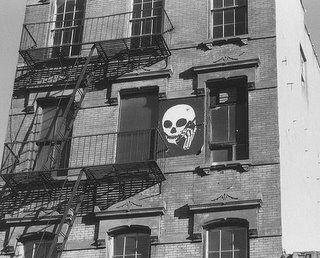• • Say "cheese"! Ready for the wrecking ball at 295 Bowery. Before demolition, part of the exterior was photographed.

___________________________________
• • Mae West was not the only writer to revisit the Bowery. In May 1904, married actors Mr. and Mrs. Terry McGovern starred in Theodore Kremer's stirring melodrama "The Bowery After Dark" at the People's Theatre. Kremer set his scenes in Suicide Hall, Chatham Square, Chinatown, etc.
• • During the 1890s The New York World commissioned artist Julius C. Fireman to illustrate the interior of Suicide Hall.
• • Unfortunately, a sketch was sketchy. You really had to BE there - - on site - - to understand how well the place functioned. Rich in real estate, John McGurk owned a 4-story establishment that he joined to a charming one-story annex. Each building fronted on the Bowery (numbered 251-253 Bowery during the 1890s) and could be exited by way of several secret passageways, so that the customer could escape an enemy easily and wind up on First Street, Second Avenue, Houston, or even in a private courtyard.
• • Owen Kildare lived in the Bowery and wrote about it. Stephen Crane set "Maggie, Girl of the Streets" [1893] near Suicide Hall. From 1880 - 1920, it's been said that no street ever made such an impression on writers as the Bowery did. The New York Times called it "the liveliest mile on the face of the earth during 1880-1895." The more the literary types set fiction there, the trendier it became to rediscover low life.

• • Mae West and the self-confessed saloon scholars understood that the Bowery boy and his female counterpart, the "Tough Girl," had to be made amusing before they would be accepted as entertainment.
• • By the time Diamond Lil sashays inside Suicide Hall, bejeweled and gowned, the sinister setting had been properly de-fanged. Public acclaim kept Mae busy, touring with the play, and then filming it as a Hollywood movie with her leading man Cary Grant.
• • According to an article [13 May 1999] in The New York Times, the building had been a hotel during the Civil War, catering to returning soldiers. By the 1890s it was a brothel and a dive where . . . a half-dozen destitute courtesans drank carbolic acid and died. John H. McGurk, the owner of the saloon on the ground floor, then capitalized on the notoriety of the place by renaming it McGurk’s Suicide hall.
• • Later, beginning in World War I and continuing into the 1950s and early 1960s, it was a flophouse for Skid Row veterans. In the mid-80’s it was converted into artists’ studios.
• • The N.Y. Times concluded: "Despite this colorful past, the city’s Landmarks Preservation Commission denied landmark status to the building, finding that it did not have sufficient historical, cultural, or architectural merit."
________________________________
Source:http://maewest.blogspot.com/atom.xml
Mae West
• • Photo • Mae West was interviewed about reprising the role of "Diamond Lil" for the silver screen [1934] • Suicide Hall in 2004
NYC
Mae West.


Sorry, it was always 295 Bowery... 253 was also owned by John McGurk prior to Suicide Hall.
ReplyDeleteNice article otherwise.
Also the home of author Kate Millett for many years, she fought for saving the building to the end.
ReplyDeleteKate Millett moved into the loft that my ex-husband and I fixed it up there in 1969. We were screwed out of it by some predatory guy. Winston Kulock, who owned a Xerox store who after we did all the work and put all of our money and labor into it, screwed us out of it. We weren’t the only ones. Each floor in the building was renovated by a bunch of 20 something art students who he thought he could take advantage of. We got a well-known artist, lawyer who got us all the money back that we spent on renovations, but not for labor. He got away very cheaply.
ReplyDelete